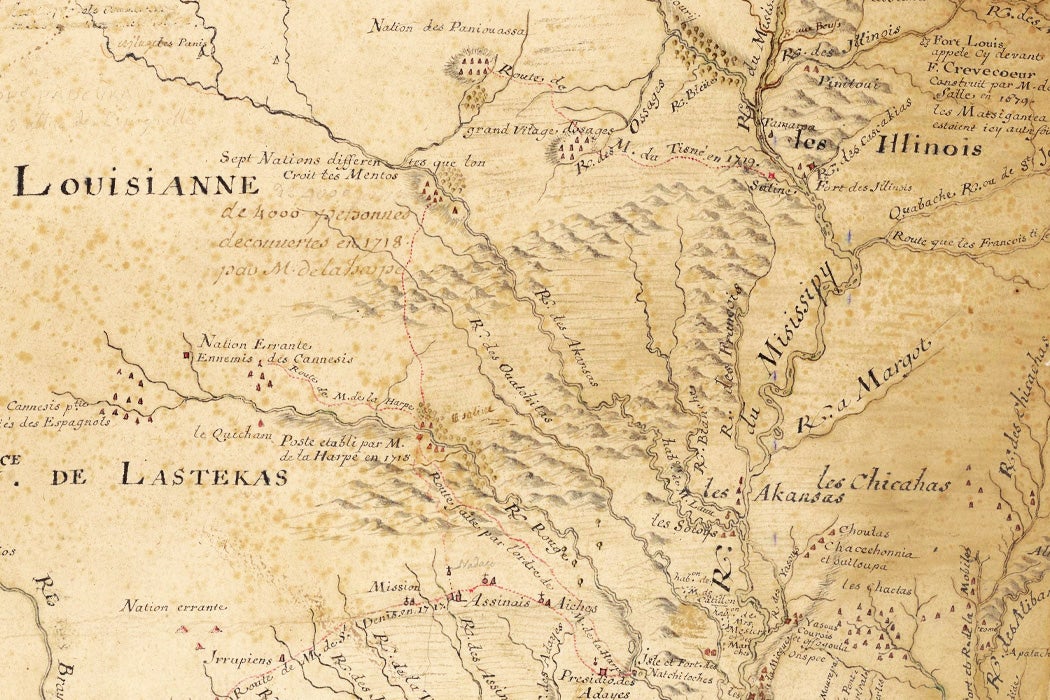During the Revolutionary War, George Rogers Clark led Americans in conquering what became known as the Old Northwest. Nominally, this region was part of Britain’s North American empire. After all, they’re the ones who ceded it to the new United States in 1783. The Indigenous peoples of this region hardly mattered to the imperial powers. Included in the latter were the French, who had been there nearly a century before the British. French Creoles—that is, those born in the colonies—were still there to greet the newest flavor of English-speakers when Americans moved west.
American colonial history concentrates on the East Coast, so it’s good to be reminded that the first Europeans to colonize the Mississippi valley were French fur-trappers and priests. From Canada to Louisiana, right through the middle of North America, there ran a thin French line, with settlements, missions, and, ultimately, mixed French-native families. Historian Robert Michael Morrissey surveys recent research of this traditionally neglected region and finds:
“[A] passage in continental, hemispheric, Atlantic, or even world history, foregrounding narratives of cultural encounter, settler society, and imperial contestation whose dynamics have less to do with eventual Illinois statehood or the American nation-state than they do with significant themes in global history in the early modern period.”
Morrissey writes that “popular awareness of the Indigenous and colonial histories from the seventeenth and eighteenth centuries in Illinois is minimal.” While recent historians of the American Midwest have been telling a more complex story of a region often cliched as “homogenous,” scholars specializing in the Illinois Country in particular have “revealed a history characterized by diversity and dynamism.”
Le pays des Illinois, the Illinois Country, was in theory a vast expanse of the Mississippi and Illinois watersheds, but its heart was that part of the mid-Mississippi that today corresponds to the states of Illinois and Missouri south of St. Louis. The main French-Native settlements were Cahokia and Kaskaskia, communities with pre-Contact histories that stretched back centuries.
In a French census in 1726, about 500 Native, European, and African people were recorded in the Illinois Country. Nearly a quarter of the population was made up of West Africans, or the descendants of West Africans, who had been slave-traded through the Caribbean. Jesuit missionaries were the first owners of Black slaves in the region. By 1752, Black slaves made up around 30 percent of the population. Illinois’s state constitution banned slavery in 1848; slavery was abolished in Missouri in 1865.
The pays was remote from both Canada and New Orleans and as such had little governmental “oversight as it grew into a substantial network of Native and Creole villages by the Seven Years’ War.” This global war, known in U.S. history as the French and Indian War, lasted from 1756-1763. It resulted in France losing much of its holdings in the western hemisphere. Canada went to Britain. The territory of Louisiana, a large chunk of North America west of the Mississippi River, was given to Spain—until 1800, when Napoleon got it back.
The treaty division of spoils had little effect on the ground for many years. French legal practices, for instance, prevailed into the 1790s. Additionally, Catholics in the pays were under the auspices of the Bishop of Quebec until 1791.
French-Indian interactions in this region, including slavery, intermarriage, and religious conversions, are now some of the best-studied examples of encounter between European settlers and the continent’s indigenous populations.
Weekly Newsletter
“Despite frequent intermarriages and close ties between French and Indians, the new history of Illinois Country does not depict the region as a fluid middle ground where diverse peoples interacted free of prejudice.”
It was multicultural, but, continues Morrissey, “the borders of community and identity were drawn in complex and often idiosyncratic ways.”
As African slavery shows, Illinois Country may have been far from the center of European imperial efforts, but it was not at all separate from them.
Support JSTOR Daily! Join our new membership program on Patreon today.







